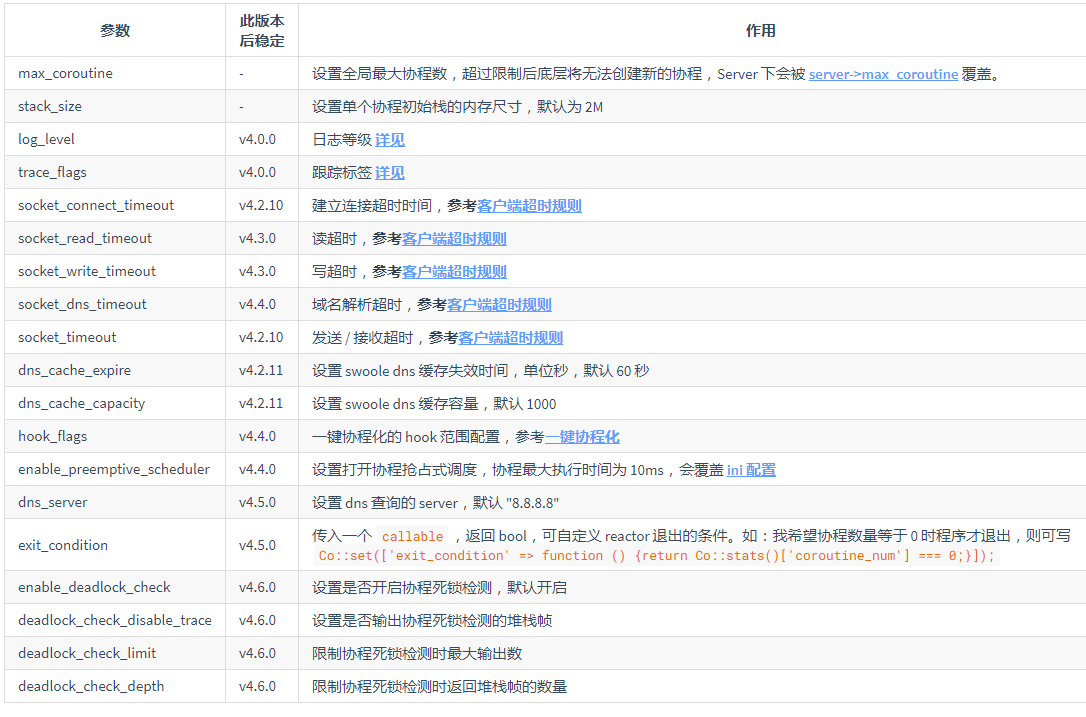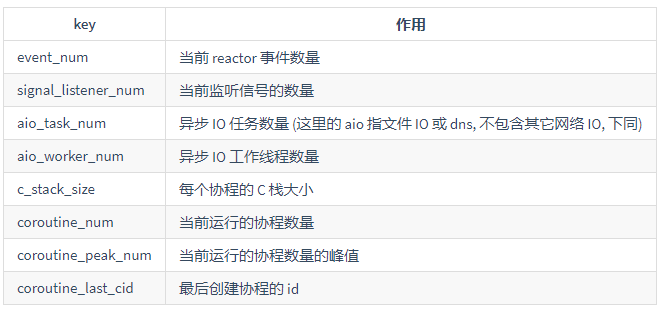本节专门介绍swoole提供的协程机制中核心的API
类方法:
1) set():协程设置,设置协程相关选项。
Swoole\Coroutine::set(array $options);

2) getOptions():获取设置的协程相关选项。
Swoole\Coroutine::getOptions(): null|array;
3) create():创建一个新的协程,并立即执行。
Swoole\Coroutine::create(callable $function, ...$args): int|false go(callable $function, ...$args): int|false // 参考php.ini的use_shortname配置
$function:协程执行的代码,必须为 callable,系统能创建的协程总数量受限于 server->max_coroutine 设置
返回值:创建失败返回 false,创建成功返回协程的 ID。
注意:由于底层会优先执行子协程的代码,因此只有子协程挂起时,Coroutine::create 才会返回,继续执行当前协程的代码。在一个协程中使用 go 嵌套创建新的协程。因为 Swoole 的协程是单进程单线程模型,因此,使用 go 创建的子协程会优先执行,子协程执行完毕或挂起时,将重新回到父协程向下执行代码;如果子协程挂起后,父协程退出,不影响子协程的执行。如下示例:
\Co\run(function() { go(function () { Co::sleep(3.0); go(function () { Co::sleep(2.0); echo "co[3] end\n"; }); echo "co[2] end\n"; }); Co::sleep(1.0); echo "co[1] end\n"; });
注意:
·每个协程都是相互独立的,需要创建单独的内存空间 (栈内存),在 PHP-7.2 版本中底层会分配 8K 的 stack 来存储协程的变量,zval 的尺寸为 16字节,因此 8K 的 stack 最大可以保存 512 个变量。协程栈内存占用超过 8K 后 ZendVM 会自动扩容。协程退出时会释放申请的 stack 内存。
·PHP-7.1、PHP-7.0 默认会分配 256K 栈内存
·可调用 Co::set([‘stack_size‘ => 4096]) 修改默认的栈内存尺寸
4) defer():defer 用于资源的释放,会在协程关闭之前 (即协程函数执行完毕时) 进行调用,就算抛出了异常,已注册的 defer 也会被执行。
Swoole\Coroutine::defer(callable $function); defer(callable $function); // 短名API
注意:需要注意的是,它的调用顺序是逆序的(先进后出), 也就是先注册 defer 的后执行,先进后出。逆序符合资源释放的正确逻辑,后申请的资源可能是基于先申请的资源的,如先释放先申请的资源,后申请的资源可能就难以释放。
示例:
go(function () { defer(function () use ($db) { $db->close(); }); });
5) exists():判断指定协程是否存在。
Swoole\Coroutine::exists(int $cid = 0): bool
示例:
\Co\run(function () { go(function () { go(function () { Co::sleep(0.001); var_dump(Co::exists(Co::getPcid())); // 1: true }); go(function () { Co::sleep(0.003); var_dump(Co::exists(Co::getPcid())); // 3: false }); Co::sleep(0.002); var_dump(Co::exists(Co::getPcid())); // 2: false }); });
6) getCid():获取当前协程的唯一 ID, 它的别名为 getuid, 是一个进程内唯一的正整数。
Swoole\Coroutine::getCid(): int
返回值:成功时返回当前协程 ID;如果当前不在协程环境中,则返回 -1
7) getPcid():获取当前协程的父 ID。
Swoole\Coroutine::getPcid([$cid]): int
$cid:协程 cid,参数缺省,可传入某个协程的 id 以获取它的父 id
示例:
var_dump(Co::getPcid()); \Co\run(function () { var_dump(Co::getPcid()); go(function () { var_dump(Co::getPcid()); go(function () { var_dump(Co::getPcid()); go(function () { var_dump(Co::getPcid()); }); go(function () { var_dump(Co::getPcid()); }); go(function () { var_dump(Co::getPcid()); }); }); var_dump(Co::getPcid()); }); var_dump(Co::getPcid()); }); var_dump(Co::getPcid()); // bool(false) // int(-1) // int(1) // int(2) // int(3) // int(3) // int(3) // int(1) // int(-1) // bool(false) /* 说明: 非嵌套协程调用 getPcid 将返回 -1 (从非协程空间创建的) 在非协程内调用 getPcid 将返回 false (没有父协程) 0 作为保留 id, 不会出现在返回值中 */
注意:协程之间并没有实质上的持续父子关系,协程之间是相互隔离,独立运作的,此 Pcid 可理解为创建了当前协程的协程 id
8) getContext():获取当前协程的上下文对象。
Swoole\Coroutine::getContext([$cid]): Swoole\Coroutine\Context
$cid:协程 cid,可选参数;默认返回当前协程的上下文对象。
作用:
· 协程退出后上下文自动清理 (如无其它协程或全局变量引用)
· 无 defer 注册和调用的开销 (无需注册清理方法,无需调用函数清理)
· 无 PHP 数组实现的上下文的哈希计算开销 (在协程数量巨大时有一定好处)
· Co\Context 使用 ArrayObject, 满足各种存储需求 (既是对象,也可以以数组方式操作)
function func(callable $fn, ...$args) { go(function () use ($fn, $args) { $fn(...$args); echo ‘Coroutine#‘ . Co::getCid() . ‘ exit‘ . PHP_EOL; }); } /** * Compatibility for lower version * @param object|Resource $object * @return int */ function php_object_id($object) { static $id = 0; static $map = []; $hash = spl_object_hash($object); return $map[$hash] ?? ($map[$hash] = ++$id); } class Resource { public function __construct() { echo __CLASS__ . ‘#‘ . php_object_id((object)$this) . ‘ constructed‘ . PHP_EOL; } public function __destruct() { echo __CLASS__ . ‘#‘ . php_object_id((object)$this) . ‘ destructed‘ . PHP_EOL; } } $context = new Co\Context(); assert($context instanceof ArrayObject); assert(Co::getContext() === null); func(function () { $context = Co::getContext(); assert($context instanceof Co\Context); $context[‘resource1‘] = new Resource; $context->resource2 = new Resource; func(function () { Co::getContext()[‘resource3‘] = new Resource; Co::yield(); Co::getContext()[‘resource3‘]->resource4 = new Resource; Co::getContext()->resource5 = new Resource; }); }); Co::resume(2); Swoole\Event::wait(); // --EXPECT-- // Resource#1 constructed // Resource#2 constructed // Resource#3 constructed // Coroutine#1 exit // Resource#2 destructed // Resource#1 destructed // Resource#4 constructed // Resource#5 constructed // Coroutine#2 exit // Resource#5 destructed // Resource#3 destructed // Resource#4 destructed
9) yield():手动让出当前协程的执行权。而不是基于 IO 的协程调度;此方法拥有另外一个别名:Coroutine::suspend()
Swoole\Coroutine::yield();
注意:必须与 Coroutine::resume() 方法成对使用。该协程 yield 以后,必须由其他外部协程 resume,否则将会造成协程泄漏,被挂起的协程永远不会执行。
示例:
$cid = go(function () { echo "co 1 start\n"; co::yield(); echo "co 1 end\n"; }); go(function () use ($cid) { echo "co 2 start\n"; co::sleep(0.5); co::resume($cid); echo "co 2 end\n"; }); Swoole\Event::wait();
10) resume():手动恢复某个协程,使其继续运行,不是基于 IO 的协程调度。
Swoole\Coroutine::resume(int $coroutineId);
$coroutineId:为要恢复的协程 ID
注意:当前协程处于挂起状态时,另外的协程中可以使用 resume 再次唤醒当前协程
示例:
$id = go(function(){ $id = co::getuid(); echo "start coro $id\n"; Co::suspend(); echo "resume coro $id @1\n"; Co::suspend(); echo "resume coro $id @2\n"; }); echo "start to resume $id @1\n"; Co::resume($id); echo "start to resume $id @2\n"; Co::resume($id); echo "main\n"; Swoole\Event::wait(); // --EXPECT-- // start coro 1 // start to resume 1 @1 // resume coro 1 @1 // start to resume 1 @2 // resume coro 1 @2 // main
11) list():遍历当前进程内的所有协程。
Swoole\Coroutine::list(): Swoole\Coroutine\Iterator Swoole\Coroutine::listCoroutines(): Swoole\Coroitine\Iterator
返回值:返回迭代器,可使用 foreach 遍历,或使用 iterator_to_array 转为数组
示例:
$coros = Swoole\Coroutine::listCoroutines(); foreach($coros as $cid) { var_dump(Swoole\Coroutine::getBackTrace($cid)); }
12) stats():获取协程状态。
Swoole\Coroutine::stats(): array
返回值:

示例:
var_dump(Swoole\Coroutine::stats()); array(1) { ["c_stack_size"]=> int(2097152) ["coroutine_num"]=> int(132) ["coroutine_peak_num"]=> int(2) }
13) getBackTrace():获取协程函数调用栈。
Swoole\Coroutine::getBackTrace(int $cid = 0, int $options = DEBUG_BACKTRACE_PROVIDE_OBJECT, int $limit = 0): array
$cid:协程的 CID,默认当前协程 CID
$options:设置选项,默认值:DEBUG_BACKTRACE_PROVIDE_OBJECT 【是否填充 object 的索引】;其它值:DEBUG_BACTRACE_IGNORE_ARGS 【是否忽略 args 的索引,包括所有的 function/method 的参数,能够节省内存开销】
$limit:限制返回堆栈帧的数量
返回值:指定的协程不存在,将返回 false;成功返回数组,格式与 debug_backtrace 函数返回值相同。
示例:
function test1() { test2(); } function test2() { while(true) { co::sleep(10); echo __FUNCTION__." \n"; } } \Co\run(function () { $cid = go(function () { test1(); }); go(function () use ($cid) { while(true) { echo "BackTrace[$cid]:\n-----------------------------------------------\n"; //返回数组,需要自行格式化输出 var_dump(co::getBackTrace($cid))."\n"; co::sleep(3); } }); }); Swoole\Event::wait();
14) printBackTrace():打印协程函数调用栈。参数和 getBackTrace 一致。
Swoole\Coroutine::printBackTrace(int $cid = 0, int $options = DEBUG_BACKTRACE_PROVIDE_OBJECT, int $limit = 0);
15) getElapsed():获取协程运行的时间以便于分析统计或找出僵尸协程
Swoole\Coroutine::getElapsed([$cid]): int
$cid:可选参数,协程的 CID;默认值:当前协程 CID
返回值:协程已运行的时间浮点数,毫秒级精度
函数:
1) batch():并发执行多个协程,并且通过数组,返回这些协程方法的返回值。
Swoole\Coroutine\batch(array $tasks, float $timeout = -1): array
$tasks:传入方法回调的数组,如果指定了 key,则返回值也会被该 key 指向
$timeout:总的超时时间,超时后会立即返回。但正在运行的协程会继续执行完毕,而不会中止
返回值:返回一个数组,里面包含回调的返回值。如果 $tasks 参数中,指定了 key,则返回值也会被该 key 指向
示例:
use Swoole\Coroutine; use function Swoole\Coroutine\batch; Coroutine::set([‘hook_flags‘ => SWOOLE_HOOK_ALL]); $start_time = microtime(true); Coroutine\run(function () { $use = microtime(true); $results = batch([ ‘file_put_contents‘ => function () { return file_put_contents(__DIR__ . ‘/greeter.txt‘, "Hello,Swoole."); }, ‘gethostbyname‘ => function () { return gethostbyname(‘localhost‘); }, ‘file_get_contents‘ => function () { return file_get_contents(__DIR__ . ‘/greeter.txt‘); }, ‘sleep‘ => function () { sleep(1); return true; // 返回NULL 因为超过了设置的超时时间0.1秒,超时后会立即返回。但正在运行的协程会继续执行完毕,而不会中止。 }, ‘usleep‘ => function () { usleep(1000); return true; }, ], 0.1); $use = microtime(true) - $use; echo "Use {$use}s, Result:\n"; var_dump($results); }); $end_time = microtime(true) - $start_time; echo "Use {$end_time}s, Done\n";
2) parallel():并发执行多个协程。
Swoole\Coroutine\parallel(int $n, callable $fn): void
$n:设置最大的协程数为 $n
$fn:对应需要执行的回调函数
示例 :
use Swoole\Coroutine; use Swoole\Coroutine\System; use function Swoole\Coroutine\parallel; $start_time = microtime(true); Coroutine\run(function () { $use = microtime(true); $results = []; parallel(2, function () use (&$results) { System::sleep(0.2); $results[] = System::gethostbyname(‘localhost‘); }); $use = microtime(true) - $use; echo "Use {$use}s, Result:\n"; var_dump($results); }); $end_time = microtime(true) - $start_time; echo "Use {$end_time}s, Done\n";
3) map():类似于 array_map,为数组的每个元素应用回调函数。
Swoole\Coroutine\map(array $list, callable $fn, float $timeout = -1): array
$list:运行 $fn 函数的数组
$fn:$list 数组中的每个元素需要执行的回调函数
$timeout:总的超时时间,超时后会立即返回。但正在运行的协程会继续执行完毕,而不会中止
示例:
use Swoole\Coroutine; use function Swoole\Coroutine\map; function fatorial(int $n): int { return array_product(range($n, 1)); } Coroutine\run(function () { $results = map([2, 3, 4], ‘fatorial‘); print_r($results); });
4) deadlock_check():协程死锁检测,调用时会输出相关堆栈信息;默认开启,在 EventLoop 终止后,如果存在协程死锁,底层会自动调用;可以通过在 Coroutine::set 中设置 enable_deadlock_check 进行关闭。
Swoole\Coroutine\deadlock_check();
以上这些就是协程核心API与使用方法了,下一节我们将一起了解swoole为我们带来的系统API
--------------------------- 我是可爱的分割线 ----------------------------
最后博主借地宣传一下,漳州编程小组招新了,这是一个面向漳州青少年信息学/软件设计的学习小组,有意向的同学点击链接,联系我吧。
原文:https://www.cnblogs.com/ddcoder/p/14286785.html